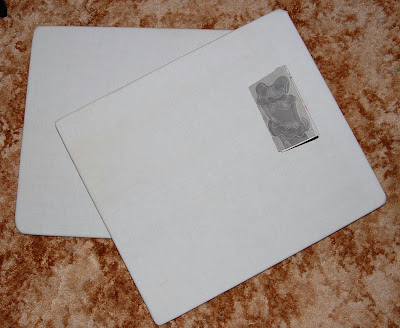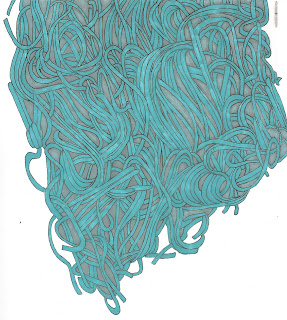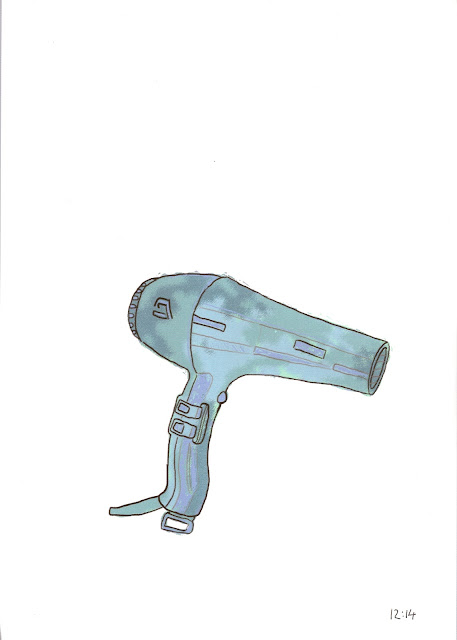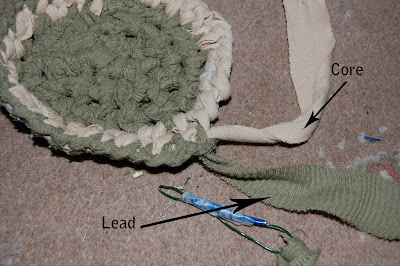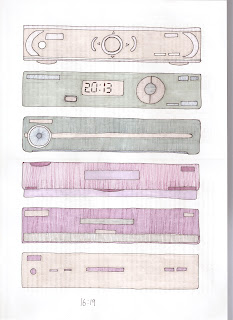Saturday, 31 March 2012
Cataloguing
These pencil/ pen drawings are based on images found in furniture/ home appliance catalogues, they're part of my continuing fascination with household objects and a follow on from some previous projects which focused solely upon objects from within my own living environment. By using catalogues and similar sources I am opening up my observation criteria to typical examples of household objects, producing images without autobiographical associations and enabling more focus on isolated objects (such as a chair) instead of scenes or fragments of an object (such as a view of part of a chair under a table).
(If you happen to wonder why the images look yellowed its because the drawings are on cream paper)
Friday, 30 March 2012
Scrabble Collage Collaborations
Ages ago me and Duncan stumbled across a communal/ collaborative project called book - for thirty-six weeks a sketchbook was sent between 4 artists - inspired by the idea of a collaborative sketchbook we decided to start one together... call it about a year later I realise that between us we've done half a page each, forgotten all about the sketchbook and subsequently buried it in amongst all my piles of art stuff.
Now considering how well me and Duncan work together and how often we work on our own individual projects whilst in the same room you'd think we'd be able to manage to do such a project, but I think we were over ambitious/ enthusiastic when we first saw 'book' and so failed to give ourself a theme or plan to keep the project together, plus you've probably noticed by now how much I flit between ideas/projects (He's just as bad for it).
So when the other day he described a project he'd heard about, ( something involving uni students being set a project where they could only work with lined paper, masking tape and white paint - he was a little vague on the details so they might have been allowed glue too) I had a bit of a brain-wave : I fancied starting a collage project where the media I allowed myself to use was decided by a random external source (rolling of the dice, flip coins etc). A couple hours of animated discussion (with Duncan of course) produced a plan to use scrabble letters and the alphabet to dicate my mediums, each letter of the alphabet would be assigned a medium ( A for Acrylic...) and I would use scrabble tiles to decide the letters for each collage.
Since we'd hatched this project idea together it was fairly predictable that we'd both want to give it a go, each of us planning our own sketchbook of scrabble collage, but then a little thought occurred to me ( spurred by the fact I'd just unearthed the poor abandoned volume) why not revive the collaborative sketchbook? It's the perfect project for it, so thats what we're going to do : a collaborative scrabble collage sketchbook... if we ever get more than half a page done I'll post them up.
Now considering how well me and Duncan work together and how often we work on our own individual projects whilst in the same room you'd think we'd be able to manage to do such a project, but I think we were over ambitious/ enthusiastic when we first saw 'book' and so failed to give ourself a theme or plan to keep the project together, plus you've probably noticed by now how much I flit between ideas/projects (He's just as bad for it).
So when the other day he described a project he'd heard about, ( something involving uni students being set a project where they could only work with lined paper, masking tape and white paint - he was a little vague on the details so they might have been allowed glue too) I had a bit of a brain-wave : I fancied starting a collage project where the media I allowed myself to use was decided by a random external source (rolling of the dice, flip coins etc). A couple hours of animated discussion (with Duncan of course) produced a plan to use scrabble letters and the alphabet to dicate my mediums, each letter of the alphabet would be assigned a medium ( A for Acrylic...) and I would use scrabble tiles to decide the letters for each collage.
Since we'd hatched this project idea together it was fairly predictable that we'd both want to give it a go, each of us planning our own sketchbook of scrabble collage, but then a little thought occurred to me ( spurred by the fact I'd just unearthed the poor abandoned volume) why not revive the collaborative sketchbook? It's the perfect project for it, so thats what we're going to do : a collaborative scrabble collage sketchbook... if we ever get more than half a page done I'll post them up.
Thursday, 29 March 2012
Other things to do with half-hitch knots
You may recognise the purple and grey knotted yarn as a friendship bracelet, thats because it's exactly the same technique - the half-hitch knot. Both these items are part finished experimental projects involving the same knot used in the rag rug technique I waffle on about on a regular basis.
The left one (afore mentioned bracelet type) is going to become either a bag strap or part of a textile art piece ( it depends on the length when I run out of yarn).
The right one (the funny shaped thing) is far more interesting - its a piece of leftover balsa wood (from one of those little modelling kits of balsa wood - you know the ones that you use to make strange models of mice, helicopters or skeletons...) which I'm wrapping in a kind of string (using half hitch) that will then have other textile items combined with it to create a experimental art piece. It all sounds very confusing/ scattered I'm sure but when you see the finished thing - currently a product of my imagination- it will all become clear...
The left one (afore mentioned bracelet type) is going to become either a bag strap or part of a textile art piece ( it depends on the length when I run out of yarn).
The right one (the funny shaped thing) is far more interesting - its a piece of leftover balsa wood (from one of those little modelling kits of balsa wood - you know the ones that you use to make strange models of mice, helicopters or skeletons...) which I'm wrapping in a kind of string (using half hitch) that will then have other textile items combined with it to create a experimental art piece. It all sounds very confusing/ scattered I'm sure but when you see the finished thing - currently a product of my imagination- it will all become clear...
Wednesday, 28 March 2012
Funky Foam trio
This is a little revival of my funky foam work ( refer to my website for images etc of the vases I made last year), a technique which involves covering a surface in sections of craft foam and stitching it together. Here you can see what will become a set of three (currently one finished, one half stitched and one not started). Its the first time I've used this funky foam technique on a flat surface, though I have some more vases and christmas baubles lined up to do, judging from the success so far I'm considering some other flat foam ideas ( maybe some frames of foam - combining this technique with another etc)
 |
| finished one |
 |
| part finished |
Tuesday, 27 March 2012
Rag Rug - the big one
This is the mammoth rag rug I'm working on ( as mentioned - briefly - in the tutorial I made a couple weeks ago on the technique), I have to work on it in dribs and drabs because I want to avoid repetitive strain/ straining my sanity but I do find it relaxing (perfect for doing whilst watching telly). It currently measures at approximately 33 inches - but I'm aiming for about 5 - 6ft
I'll post another photo when its grown significantly so we can watch its progression, but for now wish me luck...
Monday, 26 March 2012
Drop Spinning - spot the difference
As you can see in roughly two weeks (during which I've snatched the occasional 5 minutes for spinning) the amount of spinning has noticeably grown! ( well its a bit spot the difference but I think its got quite a bit more on there) i'm also getting the hang of spinning from "tufts" instead of preparing lengths to spin with - though only time will tell if I'm goot enough to do it straight from a carded fleece ( the wool tops I'm currently using is pretty damn easy to work with - that is when its not felting itself together at odd moments)
 |
| before |
 |
| now |
Saturday, 24 March 2012
Portable Printing Boards
I now have my very own portable print board, (basically a slightly soft surface to use when printing) the portable factor is particularly handy for storage and space - the last thing I need is a massive print table crowding my already packed work space. Duncan kindly made these two print boards (one each obviously) from old drawing boards (donated - on request - from the school's technology department) which were then covered with neoprene (textiles department), a waterproof layer ( plastic tablecloth) and finally a plain white top surface (cotton sheet). The waterproof layer is to protect the neoprene from inks and similar, since its the neoprene that gives the board its soft surface it would be a bad idea to allow ink to dry on it - it wouldn't stay soft for long.
I'm now really looking forward to getting some printing done...
(incidentally to see duncan in action creating these/ anything I've left out check out duncan's post)
Sunday, 11 March 2012
Drop Spinning
Started back up with my drop spinning today, its one of those processes I pick up and put down ( much like rag rugging) as the mood takes me. Really its a long term project because I intend the finished spinning to be knitted into a hooded jumper for my friend and fellow artist Duncan, truthfully he's the one that got me started on spinning in the first place so I think its quite appropriate that my first big project using the process should go to him.
Anyways its a very long way off from being a jumper, here's how far I've got:
Anyways its a very long way off from being a jumper, here's how far I've got:
Fimo First
Saturday, 10 March 2012
Extract of Pasta
It has been such a busy week! I've been spending 99% of my time working on a pasta project with students at the school I'm volunteering at.
One of the KS3 years has a textiles brief for a unit of work based around the theme of pasta, their finished product will be a cushion, at the moment we're on the observational drawing stage ( there's 9 groups of students so thats a lot of drawing). Alongside the students I've been producing my own pasta sketchbook, its a kind of part example/ part evidence of the project and demonstrates to the students how I (as an artist) would approach the brief.
here's some extracts from my pasta sketchbook:
One of the KS3 years has a textiles brief for a unit of work based around the theme of pasta, their finished product will be a cushion, at the moment we're on the observational drawing stage ( there's 9 groups of students so thats a lot of drawing). Alongside the students I've been producing my own pasta sketchbook, its a kind of part example/ part evidence of the project and demonstrates to the students how I (as an artist) would approach the brief.
here's some extracts from my pasta sketchbook:
Monday, 5 March 2012
Splat Bears
 |
| 5 Blue Splat Bears |
Before you ask, I call them splat bears because they remind me of paint splats (especially the stereotypical clipart-type paint splats). I make these cute little 3 inch (approx.) teddy bears out of leftover scraps of fabric and stuff them with similarly recycled materials. ( Note: because they are not stuffed with child-safe polyester toy filling they cannot be considered as toys. But this doesn't prevent them from being really cute decorations, keyring attachments etc.) Due to the materials I make them from each bear is unique. Additionally, as you can see, I vary the design from bear to bear: some have ribbons and some will have keyring attachments. Also some splat bears have additional stitching detail ( like the ones on the right) and I have plans to produce a few splat bears in the future with even more elaborate designs, such as embroidery all over their body and maybe even clothing items (bow ties?).
Sunday, 4 March 2012
Time Drawings, revisited
I've finally finished scanning all the drawings in the series (over 100) onto my computer, all thats left to do is upload them to my website...
During the hours I've spent scanning I've had chance to re-look at my drawings and something occurred to me: It seems like every hairdryer I've drawn (and theres a few) has something in common with sci-fi style ray guns and laser shooters (sci-fi weapons in general really), its a thought that had me tickled - just goes to show the kind of associations our brains makes.
here's some examples of the hairdryers:
During the hours I've spent scanning I've had chance to re-look at my drawings and something occurred to me: It seems like every hairdryer I've drawn (and theres a few) has something in common with sci-fi style ray guns and laser shooters (sci-fi weapons in general really), its a thought that had me tickled - just goes to show the kind of associations our brains makes.
here's some examples of the hairdryers:
Saturday, 3 March 2012
Pendant Experiment... continued
These are three of the pendant type beads I made from air dry clay on Thursday, I've painted this distressed finish using acrylics and once the others are painted in a similar fashion (though some will be painted in a different style and there will definitely be colour variation) I'll add some coats of varnish.
Because they're made of air dry clay they're not strong enough to be worn as jewellery ( if I wasn't sure of that before I am now) but I plan to put them to less strenuous use - incorporated into wallhangings or some crafty style creation, dangling harmlessly on a wall they should be pretty safe (especially after varnishing) ; plus pretty effective in appearance if any of the ideas floating through my head pan out - I'm feeling a textile collage moment approaching.
Rag Rug... How to, Part 2
This is the main part of the tutorial, the actual making of rag rugs, for preparatory stages see part 1.
In this section you will often see me refer to the core and lead fabric strips, these are terms i use to describe the two different fabric strips needed to make a rag rug
The 'core' always runs through the center of the knots, it acts as tension control and strengthens the weave. It is also essential in the starting off stage as the lead is knotted around it to create the first row.
The 'lead' is the fabric that does most of the work, it forms the most visible part of the rug and it is to the lead that the tool is attached. The lead is used to create all the knots.
Basic Half Hitch
Before I go into the details of how to start off the rag rug, I'm going to show you how the half-hitch knots are made during the rug's construction. The half-hitch is the name for the knot used to create the rag rug weave ( it is also used in the creation of friendship bracelet style knot works).
Throughout the rag rug process you will do this knot, its a repetitive motion (not dis-similar from blanket stitch) that goes as follows:
1 - Pass the ‘lead’ under the ‘core’ and through the next stitch (hole) without pulling it through.
You may find it awkward at first to see where the next stitch is but you should soon be able to pick it out with practice - like I've mentioned in part 1 of this tutorial this technique seems tricky to start with but once you've got your head round it the method will seem really straightforward.
2 - Start to pull the lead through the stitch but stop before the loop the lead is making gets too small, then put the lead through the loop and pull tight. Ta da! the first of many half-hitch knots.
Starting off:
1 - attach 2 strips together, choose a lead then use the lead to make a “4” shape over the core
2 - pass the lead under the core and through the loop of the “4”, pull it into a knot that is loose enough to fit a finger through
3- again use the lead to make a "4" shape over the core then repeat step 2. For circular rugs make about 3 knots (in total) and for oval rugs make 4, though this is the amount I use it doesn't matter if you want to add more knots on this first row it will just potentially alter the rug's final shape.
4 - carefully turn the row of knots around so the core /lead are at the top and lie on the left of the knots
5 - pass the tool/lead under the core and push through the knot you have just made (top one) ,then through the loop and pull tight
6- continue knotting into the next stitch, starting with the one down from the knot you have just made and continuing on round and round - always passing under the core, up through the next stitch and through the loop
 |
| -1- |
 |
| -2- |
 |
| -3- |
 |
| -4- |
 |
| -5- |
 |
| -6- |
In order to keep the rug flat expanding stitches are needed, to expand simply knot twice into the same stitch. I find it helps to expand frequently in the first few goes round and less as it gets bigger... if the rug starts to curl up and becomes tight you need an expanding stitch ( this is an intuitive part of the process and depends on the rug, but curling is always a sign that more stitches are needed). However, if the rug starts to have wavy edges and won't lay flat on the ground too many expanding stitches have been added, if this is spotted early you can either stop adding expanding stitches until it flattens out or occasionally miss stitches to decrease the surplus.
To make basket-like rag rugs you have to play with expansion and tension, start as normal and when the rug is big enough for the base of the "basket" stop expanding and perhaps tug the core a bit tighter, the 'rug' should soon start to curl and will eventually start expanding upwards, you can experiment with different levels of expanding stitches and missing stitches to create a variety of shapes (it literally is an experiment - i don't have any particular rules on how to do this, i simply do and adjust as i see the changes happening). In such experiments I have managed to create a vase shape and a ball so I'd say the shape possibilities are fairly endless.
When the rug is at the size you want you have numerous options-
You could tie the core and lead into a bow or decorative not,
or discreetly tie the two strips (lead/core) to previous stitches to secure them, then cut short and tuck the ends out of sight.
Or even tie a knot in the lead and core before weaving the leftovers back through the stitches like the core.
Regardless of the method the important thing is to secure the ends so they cannot unravel (not that this knot is prone to that anyway) and to finish the product off nicely.
And so that concludes the tutorial, I'll leave you with a couple of examples of my rag rug creations:
 |
| Mug Coaster |
 |
| Small Basket |
 |
| Small Basket (view 2) |
Friday, 2 March 2012
Rag Rugs - How to... Part 1
(please note: I learnt this technique through research therefore I make no claim to be the inventor or even an authority, I'm just an enthusiast)
I refer to them as rag rugs but they're also known as toothbrush rugs (additionally there are other rag rug forms and other tutorials available if you hunt them out), its a technique I've been using a lot lately (not least because I'm in the midst of making an 8ft wide one, but I've also done workshops teaching it and I've found it suitable for both children and adults alike.
There are three especial reasons why I think making rag rugs is awesome:
1 - because its so versatile, you can make basket type containers, coasters and all sorts of interesting fabric things using this technique, as well as great looking rugs (as the name suggests).
2 - once you've got your head round it, the half hitch knot used to create them is so simple you can just sit and do - much like knitting and crochet its great for repetitive creation that feels really satisfying when completed.
And 3 - its sustainable: scraps of fabric, up-cycling, clearing out wardrobes of old clothes ... all that we're really starting to embrace in the creative world applies to this technique.
But enough of my rambling, lets get on with how its actually done...
If you want to print off any of this tutorial for reference do it, 'cos starting off can be a little tricky to get your head round (but when it clicks: look out forgotten t-shirts your days are numbered), plus feel free to question me using comments or email or even better show me some of what you've created using this technique, I'd love to see them.
Before You Start:
Gather some fabric - colour, texture and type are up to you but personally I find it easier to avoid really stretchy fabrics unless they're being used on there own ( I like to have a real wacky mix so I tend to be wary of anything with more give than jersey)
Cut your fabric into strips, roughly an inch wide and a manageable length (as a rule of thumb I avoid lengths longer than my arm span, it takes less effort to pull through as your working that way), fold the end of each strip back on itself and cut a small slit-like hole - do this at each end of the strips - this is part of the method used to join fabric strips together (see below section on joining)
(TIP - you don't need to cut all the strips at once, especially if your not sure how big you want the finished product to be, its quite alright to cut a few at time as you need them)
You will also need to make (or purchase) a tool, which will act a bit like a needle. To make mine I cut a piece of thick wire (floristry wire normally) to a length of about 20cm, then bend it to have a big loop at one end and a small loop at the other, with tape (pvc, duct tape etc) around the middle, ensuring the sharp ends are covered.
I've seen other rag rug makers use coat hangers or even a sharpened toothbrush with a hole drilled into it to make their tools (hence the term toothbrush rugs)
Joining Fabric Strips:
Step 1 - push one end of the new strip through the slit (hole) in the strip you want to join on to.
Step 2 - take the bottom end of the strip you just used and push it through the top end (like a snake biting its tail)
Step 3 - pull on the end you’ve just threaded through, the loop should get smaller...
And thats all it takes to join fabric strips together, you'll need to join fabric strips as each run out.
Attaching to tool:
This is the easiest way to attach your fabric to the tool, which enables you to push through tight stitches, its particularly useful since if you reverse the below steps you can detach the strip without losing the slit in the end - meaning you can add the the next fabric strip with the method above, re-attach to the tool and carry on rag rug making for as long as you like! ( the alternative is to tie lots of knots)
 - First put the end of the strip through the large loop of wire
- First put the end of the strip through the large loop of wire- Next put the small loop through the slit in the fabric strip
- Then pull the short piece (the bit above the slit) down to the bottom of the large loop
To undo gently pull the short piece back up and over the top of the tool.
 Coming up in Part 2 -
Coming up in Part 2 - Next this tutorial will demonstrate how to start off a rag rug, carry it on (the half hitch knot) and finish it off. I'll also add tips on expanding, some variations/ experiments to try and pictures of things I've done using this technique...
Thursday, 1 March 2012
Pendant Experiment
I've been having a little play with air dry clay (rhyming that wasn't intentional, but its happened so its staying), making pendants and beads from it, they're now pretty much dry so next I intend to paint/varnish etc. though of course all my efforts might be in vain since air dry clay is not particularly strong (the batch I have is on the powdery/ crumbly side) and may not survive or just simply not respond well to the processes I have planned for it. Either way I'll post the results ...
Time Drawings
I'm currently in the process of uploading a large series of drawings I produced in november to my website. There are over 100 drawings created using various mediums, all inspired by the phrase "of our time". Each drawing is of a technological/ electric household object, objects typical to our time - that are commonly used in our day to day activities but not always appreciated aesthetically.
All of the drawings are created on recycled paper, such as discarded photocopies. Its also worth mentioning that some of the drawings experiment with digital processes, for example, a printed photo which has been worked over or digitally rendered drawings that were then printed to be shown as part of the series. (there's a double digital happening with such pieces, they went from digital to physical and now will be seen online back in digital form)
Since there are so many drawings I thought I'd offer a little preview here first:
(to see the rest follow this link - http://www.wix.com/lsaallen13/artist#!current/vstc5=time-drawings)
All of the drawings are created on recycled paper, such as discarded photocopies. Its also worth mentioning that some of the drawings experiment with digital processes, for example, a printed photo which has been worked over or digitally rendered drawings that were then printed to be shown as part of the series. (there's a double digital happening with such pieces, they went from digital to physical and now will be seen online back in digital form)
Since there are so many drawings I thought I'd offer a little preview here first:
(to see the rest follow this link - http://www.wix.com/lsaallen13/artist#!current/vstc5=time-drawings)
Subscribe to:
Comments (Atom)






